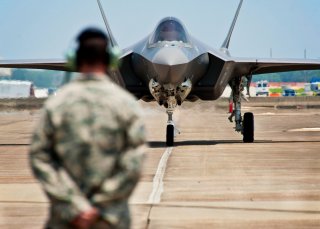Another Reason Nothing Can Stop the F-35 Stealth Fighter
ODIN is designed to anticipate potential failures well before malfunctions arise to both preserve the safety and survivability of the aircraft and also streamline the repair and maintenance process by getting ahead of the curve.
By as soon as 2022, the Pentagon’s F-35 Joint Strike Fighter is expected to operate with an advanced onboard computing system intended to ensure optimal functionality, improve maintenance and sustainment by anticipating points of failure, monitor aircraft systems and help organize data.
For the F-35 aircraft, far more matters than its weapons, stealth characteristics, and combat capability; Logistics, sustainment, and conditioned-based maintenance factors are also of critical importance. This explains why the jet is now being upgraded with an advanced new computer system to replace its Autonomic Logistics Information System (ALIS) with a new, more-capable system called Operational Data Integrated Network (ODIN). ODIN, regarded as a follow-on upgrade to the sometimes technically challenged ALIS system, is slated to be fully operational by 2022.
Unlike its predecessor ALIS, ODIN may not be narrowly configured to purely perform maintenance functions but may also impact and improve aircraft information processing, management, and transmission.
As a high-speed, diagnostic computer system, ODIN will perform a number of critical functions. One of those is conditioned-based maintenance wherein onboard sensors and computers monitor flight systems such as engine rotations or cooling functions. ODIN will also examine the component health of onboard software and hardware throughout the aircraft such as avionics and other electronics.
ODIN is designed to anticipate potential failures well before malfunctions arise to both preserve the safety and survivability of the aircraft and also streamline the repair and maintenance process by getting ahead of the curve. Most of all, this kind of diagnostic or predictive computer system kind can mitigate the risk of any kind of in-flight malfunction that could introduce operational challenges. Engine performance and reliability, electronics and cooling systems, and weapons delivery technologies need to be monitored for health and maintenance. This streamlines the repair and maintenance process in a way that improves the consistency of performance and also saves money by stabilizing the supply chain.
These capabilities are crucial factors affecting whether the F-35 fighter can continue to maintain a high mission-readiness rate and can quickly receive upgraded electronics or spare parts.
ODIN is the kind of system likely to impact the often less-recognized issue of F-35 sustainment. Questions pertaining to sustainment and operating costs of an F-35 persist, and yet the dynamic is very likely to be measurably improved with the arrival of ODIN which can ensure a level of predictability, planning, and supply delivery sufficient to lower costs considerably.
Kris Osborn is the defense editor for the National Interest. Osborn previously served at the Pentagon as a Highly Qualified Expert with the Office of the Assistant Secretary of the Army—Acquisition, Logistics & Technology. Osborn has also worked as an anchor and on-air military specialist at national TV networks. He has appeared as a guest military expert on Fox News, MSNBC, The Military Channel, and The History Channel. He also has a Master’s Degree in Comparative Literature from Columbia University.
Image: Flickr.

